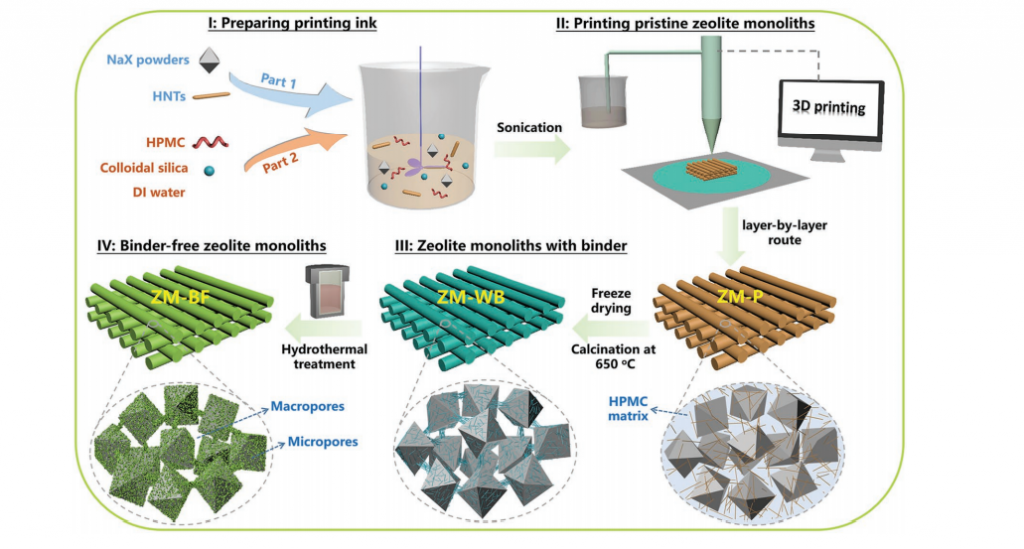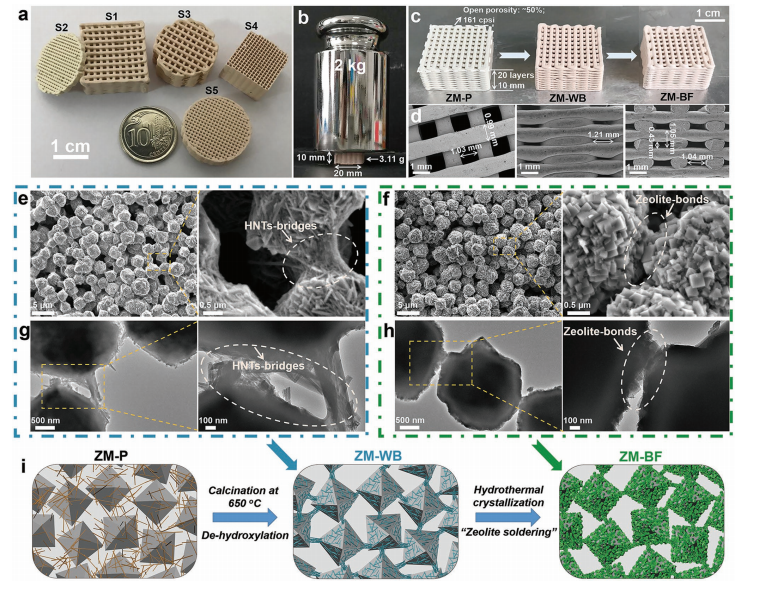3D Printing Being Combined with Soldering to Create High-Performance Zeolites
Researchers in China are exploring the use of minerals called zeolites, hoping to harness ‘desirable configurations’ via 3D printing and soldering, which is further outlined in ‘Fabricating Mechanically Robust Binder-Free Structured Zeolites by 3D Printing Coupled with Zeolite Soldering: A Superior Configuration for CO2 Capture.’
The concern of the authors is that 3D printing is simply not enough, due to issues with mechanical properties—along with absorption problems and diffusion kinetics challenges. For this study, they attempt to construct robust zeolite monoliths for use in practical applications. In conventional work, zeolite crystals are usually included in smaller structures such as pellets, for industrial fabrication. An optimized configuration is usually required, however, due to potential issues such as slow heat transfer, substantial pressure drops, and other obstacles to functionality. Traditional ‘strategies’ usually include deposition of zeolite powder onto foams, alloys, or even cordierite; or, using self supports via freeze casting, templating, crystallization, and other types of processing.

Schematic diagram of fabrication procedure of 3D-printed mechanically robust binder-free zeolite monoliths: I) a homogenous printing ink with optimal viscosity was obtained by mixing “part 1” and “part 2” including NaX powders, HNTs, HPMC, colloidal silica, and deionized water. II) The zeolites containing inks extruded through a nozzle in a 3D printing system followed the well-designed movement controlled by a computer, resulting in ZM-P. III) High-temperature calcination treatment to obtain ZM-WB. IV) Hydrothermal crystallization to produce ZM-BF.
Previously 3D printed zeolites have been limited due to mechanical strength:
“The tradeoff among mechanical strength, mass loading of active zeolites, and diffusion kinetics remain a challenging hurdle for the practical application of 3D-printed structured zeolites. Thus, it is highly desirable to develop a facile strategy to fabricate 3D-printed binder-free hierarchically structured zeolites with merit of fusing mechanical robustness, fast mass diffusion, and high zeolite loading for the practical pressure/temperature swing adsorption.”
The research team created a proof-of-concept study, developing binder-free NaX zeolite monoliths (ZM-BF) with the following features:
- Robust mechanical integrity
- Hierarchical structure
- Outstanding CO2 adsorption capacity
3D printing and traditional hydrothermal crystallization were successfully fused in creating high-performance zeolites in:
- Gas separation
- Catalysts
- Sensoring
- Other advanced applications
To strengthen the 3D printed zeolite monolith, the researchers used a printing ink with 14 wt% HNTs in the study.
“The addition of appropriate amount of colloidal silica as extra silicon source was to inhibit the transformation of HNTs into zeolite A,” stated the researchers. “The mixture was stirred thoroughly for 2 hours, followed by sonication to ensure homogeneity and avoid air bubbles. By using the above printing inks, a nozzle settled at a 3D printer was employed to print predesigned geometry via a layer-by-layer route. The as-prepared ZM-P was then freeze-dried to prevent partial shrink and collapse, followed by calcination at 650 °C to enhance the mechanical stability and form abundant macropores by removing the HPMC matrix.”

Physical and microstructural characterizations of 3D-printed zeolite monoliths. a) PXRD patterns of NaX zeolite powder, ZM-WB, and ZM-BF. Note: peaks marked with black dot are the characteristic diffraction peaks of zeolite NaA. b) N2 adsorption–desorption isotherms of the NaX powder, ZM-WB, and ZM-BF. c) The PSD curves of the NaX powder, ZM-WB, and ZM-BF derived from DFT method. d) PSD curves of ZM-WB and ZM-BF determined by mercury intrusion porosimetry. e,f) Representative stress–strain curves (e) and compressive strength (f) of 3D-printed zeolite monoliths fabricated with various printing ink additives.
With the introduction of halloysite nanotubes, the research team is able to combine ‘robust-interfacial HNT bridges’ with the crystals—successfully turning them into a connected network of bonds, allowing them to further meet their goal of strengthening the mechanical stability.
“The dynamic breakthrough tests demonstrate the superiority of ZM-BF over commercial benchmark NaX zeolites for selectively capturing CO2 from flue gas, nature gas, and biogas. To the best of our knowledge, this 3D-printed binder-free zeolite monolith is the first case of structured zeolites that fully overcomes the trade-off among mechanical strength, diffusion kinetics, and adsorption capacity,” concluded the researchers.
“We believe that the ‘3D printing and zeolite soldering’ strategy of current study may afford a versatile pathway for designing and fabricating other binder-free hierarchically structured zeolites, which may open more advanced applications of 3D-printed zeolites not only in adsorption but also in other areas such as catalysis and sensoring.”
3D printing users around the world continue to battle the challenges of diminished mechanical properties amidst innovation, and many meet with success in a variety of different projects, from examining porosity to studying biocompatibility, to using different techniques like heat treatment. What do you think of this news? Let us know your thoughts! Join the discussion of this and other 3D printing topics at 3DPrintBoard.com.

a,b) Digital photographs of ZM-BF with tailorable geometries and robust mechanical stability. c) Digital photographs of ZM-P, ZM-WB, and ZM-BF. d) Low-magnification SEM images of a representative ZM-BF: top view, side view, and cross-sectional view. e–h) High-magnification SEM images and TEM images of the cross-section of ZM-WB (e,g) and ZM-BF (f,h). i) The schematic of the procedure of zeolite soldering.
Subscribe to Our Email Newsletter
Stay up-to-date on all the latest news from the 3D printing industry and receive information and offers from third party vendors.
Print Services
You May Also Like
Low-cost “Suzy” Polymer Powder 3D Printer is Faster and Cheaper than Past Models
Polish laser powder bed fusion (LPBF) firm Sinterit has released a follow-up to its predecessors, Lisa and Nils, called Suzy, a $19,490 printer equipped with a 30W fiber diode laser....
India’s $58M Space Fund Is a Boon for AM Innovation
India’s space industry is picking up serious momentum. With a projected $44 billion space economy by 2033, the country is aggressively expanding its capabilities, fostering private-sector participation, and reducing its...
Japanese Advanced Manufacturing Capabilities Grow in Europe with Sodick’s Purchase of Prima Additive
The global economy is currently undergoing a reshuffling in terms of what gets manufactured where. In large part, this trend is being driven by new geopolitical alliances and the need...
Bosch Invests €6M into Serial Auto Part 3D Printing
German industrial conglomerate Robert Bosch GmbH, the world’s largest supplier of automotive parts, has announced a new investment into Nuremberg, Germany additive manufacturing (AM) facility. The nearly €6 million in...



























